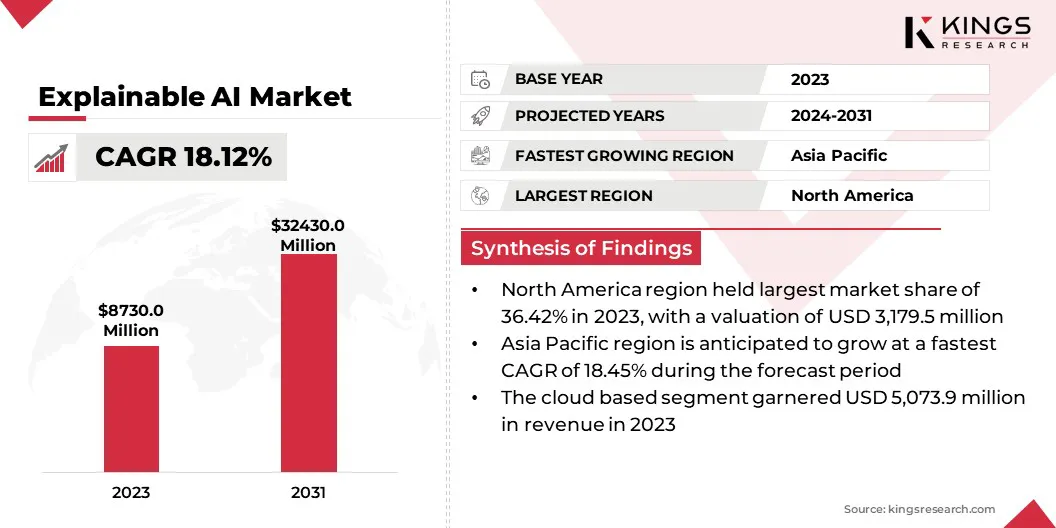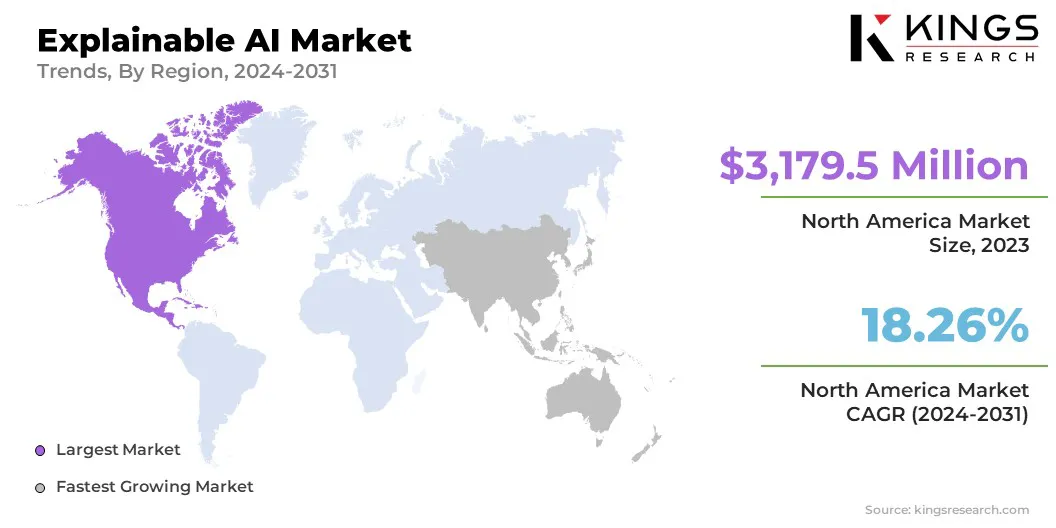Semiconductor and Electronics

Explainable AI Market

Explainable AI Market Size, Share, Growth & Industry Analysis, By Offering (Software, Services), By Deployment (Cloud Based, On Premises), By Application (Fraud and Anomaly Detection, Drug Discovery & Diagnostics), By End-Use Industry, and Regional Analysis, 2024-2031
Pages : 200
Base Year : 2023
Release : March 2025
Report ID: KR1585
Market Definition
The market encompasses software and services designed to enhance AI transparency across industries. It includes cloud-based and on-premises solutions for applications such as fraud detection, drug discovery, and predictive maintenance.
Key end-use sectors include BFSI, healthcare, IT & telecommunications, aerospace & defense, ensuring accountable AI decision-making.
Explainable AI Market Overview
The global explainable AI market size was valued at USD 8,730.0 million in 2023 and is projected to grow from USD 10,105.8 million in 2024 to USD 32,430.0 million by 2031, exhibiting a CAGR of 18.12% during the forecast period.
This growth is driven by the increasing adoption of AI across industries, coupled with the rising need for transparency, accountability, and regulatory compliance in AI-driven decision-making. Organizations are investing in explainable AI to improve risk management, customer trust, and AI model performance while mitigating bias and ensuring fairness.
Major companies operating in the explainable AI industry are Gyan, Inc., Intellico, Tensor AI Solutions, Accenture, Tredence.Inc., Fiddler, IBM, C3.ai, Inc., Intel Corporation, Google, Mphasis, Temenos Headquarters SA, Salesforce, Inc, Equifax, Inc., FICO, and others.
With increasing regulatory scrutiny and the expansion of generative AI, organizations are investing in interpretability solutions to enhance trust, mitigate risks, and ensure responsible AI deployment across diverse industries.
- In February 2024, Ericsson launched Explainable AI (XAI) capabilities within its Cognitive Software portfolio, enabling communications service providers (CSPs) to gain full transparency into AI-driven network optimization. This advancement helps CSPs quickly identify root causes of network issues, improve decision-making, and accelerate AI adoption for enhanced performance and user experience.

Key Highlights:
- The explainable AI industry size was recorded at USD 8,730.0 million in 2023.
- The market is projected to grow at a CAGR of 18.12% from 2024 to 2031.
- North America held a share of 36.42% in 2023, valued at USD 3,179.5 million.
- The software segment garnered USD 4,935.1 million in revenue in 2023.
- The cloud based segment is expected to reach USD 19,690.4 million by 2031.
- The fraud and anomaly detection segment is projected to generate a valuation of USD 13,640.2 million by 2031.
- The banking, financial services, and insurance (BFSI) segment is likely to reach USD 10,799.0 million by 2031.
- Asia Pacific is anticipated to grow at a CAGR of 18.45% through the forecast period.
Market Driver
Rising Demand for Ethical and Responsible AI
The growth of the explainable AI market is driven by the increasing emphasis on ethical and responsible AI practices. As AI adoption accelerates, concerns regarding bias, fairness, and accountability in automated decision-making have intensified.
Organizations face pressure from stakeholders, customers, and regulatory bodies to ensure transparency and eliminate discrimination in AI-driven decisions.
Businesses deploying AI in critical applications such as hiring, lending, and medical diagnostics are recognizing the importance of responsible AI to foster trust and mitigate reputational risks. Explainable AI solutions help identify and rectify biases, ensuring fair outcomes while aligning with corporate social responsibility (CSR) initiatives.
Market Challenge
High Computational Costs
A major challenge hampering the expansion of the explainable AI market is the high computational cost associated with implementing interpretability techniques. Explainable AI implementation requires extensive computation to analyze model predictions and generate clear, traceable insights.
These methods often involve running multiple iterations, modifying input data, or training additional models, increasing processing time and infrastructure demands. For enterprises deploying AI at scale, particularly in time-sensitive applications such as fraud detection, healthcare diagnostics, and autonomous systems, these added resource requirements can hinder adoption and efficiency.
To overcome these challenges, businesses can optimize their AI workflows and use scalable, cost-effective technologies. A strategic approach is to prioritize model transparency in critical areas such as high-risk transactions, regulatory reporting, and customer-facing AI systems, ensuring efficiency without unnecessary complexityacross all AI functions.
Market Trend
Expansion of Explainable AI in Generative AI Applications
A key trend in the market is the increasing emphasis of interpretability in generative AI applications. As large language models (LLMs) and generative AI tools gain traction, businesses seek transparency into generative AI outputs, particularly in content creation, automated decision-making, and AI-driven recommendations.
Interpretability solutions for LLMs are being developed to provide token attribution, contextual reasoning, and bias detection, ensuring responsible deployment. This trend is expected to accelerate as generative AI adoption expands across industries such as media, marketing, and customer service.
- In May 2024, Temenos launched Responsible Generative AI solutions, enhancing its AI-driven banking platform. Leveraging patented Explainable AI (XAI) technology, the launch enables banks to deploy AI faster and safer, improving decision-making, financial crime detection, and operational efficiency while ensuring transparency and regulatory compliance.
Explainable AI Market Report Snapshot
|
Segmentation |
Details |
|
By Offering |
Software (Standalone Software, Integrated Software, Automated Reporting Tools, Others), Services (Consulting Services, Deployment and Integration Services, Training and Education Services, Others) |
|
By Deployment |
Cloud Based, On Premises |
|
By Application |
Fraud and Anomaly Detection, Drug Discovery & Diagnostics, Predictive Maintenance, Others |
|
By End-Use Industry |
Banking, Financial Services, and Insurance (BFSI), Healthcare, IT and Telecommunications, Aerospace and Defense, Others |
|
By Region |
North America: U.S., Canada, Mexico |
|
Europe: France, UK, Spain, Germany, Italy, Russia, Rest of Europe |
|
|
Asia-Pacific: China, Japan, India, Australia, ASEAN, South Korea, Rest of Asia-Pacific |
|
|
Middle East & Africa: Turkey, UAE, Saudi Arabia, South Africa, Rest of Middle East & Africa |
|
|
South America: Brazil, Argentina, Rest of South America |
Market Segmentation
- By Offering (Software and Services): The software segment earned USD 4,935.1 million in 2023 due to the growing demand for AI-powered analytics and decision-making tools that provide transparency and accountability.
- By Deployment (Cloud Based and On Premises): The cloud based segment held a share of 58.12% in 2023, propelled by the increasing adoption of scalable and cost-effective AI solutions.
- By Application (Fraud and Anomaly Detection, Drug Discovery & Diagnostics, Predictive Maintenance, and Others): The fraud and anomaly detection segment is projected to reach USD 13,640.2 million by 2031, as a result of the rising need for real-time fraud prevention in banking, insurance, and e-commerce sectors.
- By End-Use Industry (Banking, Financial Services, and Insurance (BFSI), Healthcare, IT and Telecommunications, and Aerospace and Defense): The banking, financial services, and insurance (BFSI) segment is projected to reach USD 10,799.0 million by 2031, fuled by the increasing regulatory scrutiny on AI-driven decision-making in financial transactions, credit scoring, and risk management.
Explainable AI Market Regional Analysis
Based on region, the global market has been classified into North America, Europe, Asia Pacific, Middle East & Africa, and Latin America.

North America explainable AI market share stood at around 36.42% in 2023, valued at USD 3,179.5 million. This dominance is is reinforced by substantial investments in AI research, a well-established technology ecosystem, and regulatory frameworks emphasizing transparency and accountability in AI-driven decision-making.
The region is home to leading AI companies, including Google and IBM, which are actively developing and integrating tools into AI solutions.
The increasing deployment of AI in fraud detection, autonomous systems, and medical diagnostics further fuels regional market growth. Continuous advancements in machine learning interpretability and responsible AI frameworks reinforce the position of the regional market.
Asia Pacific explainable AI industry is poised to grow at a significant CAGR of 18.45% over the forecast period, supported by rapid digital transformation, increasing AI adoption across industries, and supportive government initiatives promoting AI research and development.
Countries such as China, Japan, and India are investing heavily in AI-driven solutions, with a growing emphasis on enhancing transparency and fairness in automated decision-making. As businesses prioritize ethical and interpretable AI, Asia Pacific is expected to emerge as a key market for explainable AI.
- In March 2024, the Government of India launched the IndiaAI Mission, emphasizing Safe & Trusted AI to strengthen AI governance. This initiative fosters indigenous explainable AI solutions, aligning with regional diversity and regulatory needs.
Regulatory Frameworks
- In the U.S., the Federal Trade Commission (FTC) regulates the market by enforcing consumer protection laws to ensure fairness, transparency, and impartiality, particularly in financial services, healthcare, and digital advertising.
- In Japan, the Ministry of Economy, Trade and Industry (METI) regulates the market by setting policies that promote transparency, accountability, and responsible AI adoption. METI provides governance frameworks and ethical guidelines to ensure AI systems align with industry standards, fostering innovation while maintaining regulatory compliance across various sectors.
Competitive Landscape
The explainable AI industry is highly competitive, with established technology firms, emerging AI startups, and research-driven enterprises striving foe leadership. Companies are prioritizing AI transparency to ensure regulatory compliance and meet industry demands for responsible AI.
To strengthen their market presence, businesses are investing in advanced machine learning techniques, algorithmic transparency, and AI governance frameworks. Strategic initiatives such as partnerships, mergers, and acquisitions are fostering innovation, allowing firms to integrate features into AI-powered applications across sectors such as finance, healthcare, and autonomous systems.
- In February 2024, Fujitsu Limited and Nagoya University collaborated to integrate advanced explainable AI models into space weather prediction systems. This initiative aims to enhance risk assessment for lunar and Martian exploration, aligning with the Japan Aerospace Exploration Agency’s mission to improve forecasting accuracy for solar energetic particle events.
List of Key Companies in Explainable AI Market:
- Gyan, Inc.
- Intellico
- Tensor AI Solutions
- Accenture
- Tredence.Inc.
- Fiddler
- IBM
- C3.ai, Inc.
- Intel Corporation
- Mphasis
- Temenos Headquarters SA
- Salesforce, Inc
- Equifax, Inc.
- FICO
Recent Developments (New Product Launch)
- In December 2024, Arya.ai launched AryaXAI, a cutting-edge AI explainability platform within the Aurionpro Enterprise AI suite. Designed for mission-critical applications, it enhances AI transparency, regulatory compliance, and ethical alignment, addressing the demand for accountable AI in high-stakes industries.
- In May 2024, Fujitsu launched an explainable AI technology for genomic medicine, enabling precise cancer classification by analyzing text, images, and numerical data. This innovation improves medical decision-making by creating knowledge graphs, allowing researchers and clinicians to extract meaningful insights with greater transparency.
CHOOSE LICENCE TYPE
CUSTOMIZATION OFFERED
Additional Company Profiles
Additional Countries
Cross Segment Analysis
Regional Market Dynamics
Country-Level Trend Analysis
Competitive Landscape Customization
Extended Forecast Years
Historical Data Up to 5 Years
.webp)